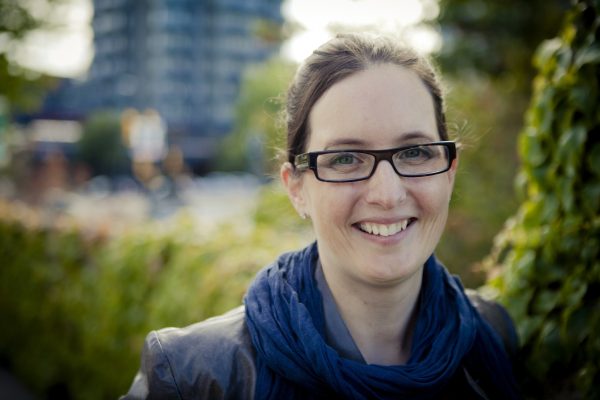Embedding sustainability in organizational culture
Mar 26, 2013
 Stephanie Bertels assembles working group to tackle environmental awareness, outcomes.
Stephanie Bertels assembles working group to tackle environmental awareness, outcomes.
Organizations in a number of business sectors are still struggling to embed sustainability into their culture. While this is not a challenge that will be accomplished overnight, it is one that Beedie School of Business assistant professor Stephanie Bertels is attempting to unravel.
Bertels has a long-standing interest in sustainability, specifically how organizations can develop and implement innovative strategies for a sustainable future. Her latest research has resulted in tangible outcomes that are already helping organizations achieve their goals. What makes this even more impressive is that the research is still in its early stages.
In partnership with the Network for Business Sustainability (NBS), Bertels has assembled a new working group of companies to collaborate on a three-year project on embedding sustainability into organizational cultures. According to Bertels, “not only is the research novel, but the process being used to undertake the research is extremely novel.”
Each year, NBS identifies a list of sustainability challenges that organizations are struggling to cope with, one of which concerned embedding sustainability into organizations. Bertels first became involved with NBS when she successfully answered a call for researchers to conduct a systematic review on the topic.
The systematic review resulted in the development of a framework for embedding sustainability into operations and culture. In addition, it also created an assessment tool, that allowed companies to see where their sustainability initiatives stood, what areas they were performing well in, and where they could improve. The tool proved to be the starting point for the next step in her research.
“After we released the systematic review we started to get companies approaching us saying that they had used the assessment tool, but wanted to know how their efforts compared to others and where they could go next,” says Bertels. “This became an intriguing question for me: how do we develop a system to compare what organizations are doing, and also get a sense of what practices are important along the different stages of the journey?”
Bertels decided to assemble a working group in order to build upon the systematic review, examining what companies are doing to embed sustainability throughout their organizations and how this work evolves as they make progress.
Each member of the group, which comprises Teck, Suncor, Bentall Kennedy, Sustainalytics, ConocoPhillips Canada, Lanxess Canada, Cenovus, TD Bank, and Farm Credit Canada, has committed significant financial resources to the project. Bertels stresses, however, that it is the group members’ dedication to the partnership and sharing of best practices that are the real contributions.
“Our goal is to ultimately move beyond an academic paper or report to an interactive tool that will support these organizations in completing the work they need to do,” says Bertels. “This is the most exciting and innovative piece of this research – it’s very different to what you would normally think about academic researchers doing.”
Collaboration for tangible outcomes
The working group will meet this spring in order to compare their results so far across organizations in a cross-sectional standpoint, before going on to develop action plans that will support each other as they progress. Already, many of the organizations involved have held informal discussions to share insights on different initiatives they have implemented.
The inter-disciplinary sharing does not end with the working group. After obtaining a SSHRC grant, Bertels partnered with faculty in SFU’s School of Interactive Art and Technology to develop a visualization tool to assess how well organizations are embedding environmental and social sustainability into their organizational cultures.
“Nothing existed to measure collective efficacy related to sustainability, and we wanted companies to be able to build a picture over time of where they were strong,” says Bertels. “The model is built on the experience of larger companies, but the idea is that small to medium sized companies will eventually be able to use it, resulting in a large repository of systematic data for comparison.”
Although the project is in its infancy, much of the feedback so far has been enthusiastic. Bertels has presented the results to the Chemistry Industry Association of Canada, and the United Nations Financial Initiative’s North American environmental working group, as well as to 800 of Walmart’s suppliers and vendors.
Many of those involved in the working group have articulated that they view it as more than just traditional academic research, with the framework and visualization tool already implemented in many organizations. One such organization is Suncor, with Gord Lambert, vice-president of sustainability, commenting, “This practical diagnostic tool has helped us assess the strengths and weaknesses of our internal culture.”
“Our members have told me that they use the tool as a visual means of demonstrating all the initiatives going on across their organization,” says Bertels. “It allows them to illustrate that sustainability isn’t just the job of their sustainability group, but rather that it needs to be embedded across the entire organization. That is exactly the sort of visible value we were aiming for when we created this tool.”
For more information on the NBS Culture Project, visit http://nbs.net/topic/culture/organizational-culture/
About Developer Marketing
This is bio!
Twitter •
